Contents
Market Overview
Macro Review
The week started with a risk-on tone but ended in a risk-off mood. Blame it on the U.S. “inflation genie”; it appears to still be at large out of its bottle and markets are starting to think that the Fed might need to provide stronger arguments to put it back in. Global investors expected that August numbers might hint at U.S. inflation having passed its peak, but higher than expected YoY and MoM prints for both headline and core CPI revealed a still increasing trend. This led to a hawkish shift in Fed rate tightening expectations. After the data release, the USD gained broadly after some retreat earlier in the week, global equity markets came under pressure and UST yields soared to multi-year highs, with the entire curve coming under flattening pressure amid reinvigorated concerns about a hard landing of the U.S./global economy. Economic bellwether commodities such as copper and other base metals have also started to flash caution signals on the outlook for the global economy. In this context, the 2Y UST yield seems to be a particularly important gauge to look at in the near future, being at the verge of breaking into 4% territory. In this highly fluid context, investors are now turning their attention to the FOMC meeting next week where a 75bps increased to the Fed Funds rate appears to be all but certain, while some are urging the Fed to deliver a bolder 100bps hike. However, better than expected readings on long-term inflation expectations in the preliminary University of Michigan survey of consumers for September, the last important release before next week’s FOMC, probably tilt the balance in favor of 75bps. Elsewhere, Chinese economic data came stronger than expected this week, indicating a degree of domestic economic resiliency despite ongoing challenges, but that is unlikely to alter the overall narrative of structurally weaker economic activity this year amid stop and go COVID policies and headwinds to the property sector. Also notably, the USDCNH breached the symbolic 7.00 level for the first time in the post-pandemic era.
EM Credit Update
Emerging markets sovereign credit ended the week 0.8% down with spreads 3bps wider. Corporate credit was 0.4% down with spreads 6bps tighter. Sovereign outperformers this week were Ukraine, Iraq and Tunisia while Sri Lanka, Tajikistan, and Zambia underperformed.
The Week Ahead
A very busy week for central banks in DM and EM. The key macro event for global markets next week will be the FOMC rate decision on Wednesday, September 21st in the U.S., which will come a day after PBOC’s policy rate decision in China. The Bank of England and Norges Bank are expected to make 50bp moves. In EM, there should be no expectations for any rate hikes by the Turkish Central Bank, but next week’s policy meeting on Thursday will show if easing of monetary policy will continue, despite rampant inflation. Among orthodox EM central banks, Brazil, South Africa and Indonesia are also due to deliver what we expect to be policy rate hikes in all three cases.
Highlights from emerging markets discussed below include: Argentina’s Super Minister Massa and technical team conclude constructive visit to the U.S.; El Salvador’s debt buyback signals high willingness to pay but questions about ability remain.
Fixed Income
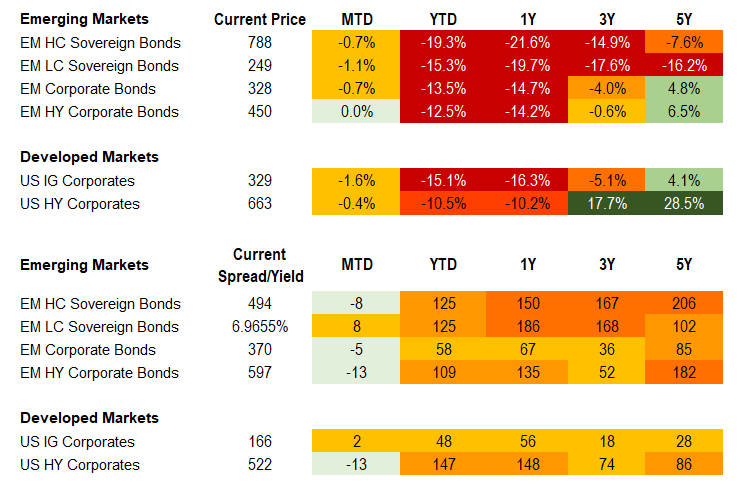
Equities
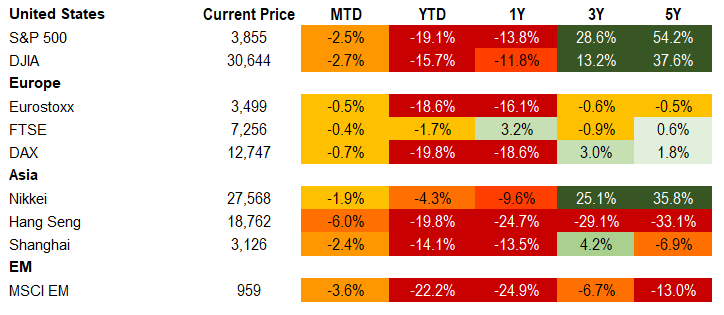
Commodities

Source for data tables: Bloomberg, JPMorgan, Gramercy. EM Fixed Income is represented by the following JPMorgan Indicies: EMBI Global, GBI-EM Global Diversified, CEMBI Broad Diversified and CEMBI Broad High Yield. DM Fixed Income is represented by the JPMorgan JULI Total Return Index and Domestic High Yield Index. Fixed Income, Equity and Commodity data is as of September 16, 2022 (mid-afternoon).
Emerging Markets Weekly Highlights
Argentina’s Super Minister Massa and technical team conclude constructive visit to the U.S.
Event: Sergio Massa held a variety of high-level meetings during his trip to the U.S., most notably with IMF Managing Director, Kristalina Georgieva, United States Secretary of the Treasury, Janet Yellen , and the Inter-American Development Bank (IADB), where he confirmed financing of roughly $5bn between now and next year. The IMF’s press release on the meetings emphasized the Fund’s support of Argentina’s progress in critical areas of an updated macroeconomic framework, policies needed to meet fiscal targets, and associated reserve accumulation. A staff-level agreement on the next review is anticipated in the coming days.
Gramercy commentary: Massa’s U.S. tour reflects his strong ties in Washington and recognition of his ability to execute on policy domestically as a pragmatic and veteran politician, which is vital to stabilizing the fragile macroeconomic backdrop. Improved relations with the IADB as well as the resumption of Paris Club negotiations are welcomed after uncertainty in the aftermath of Guzman’s departure. Massa’s comments at various events emphasized their commitment to the 2.5% of GDP 2022 primary deficit target, shoring-up FX reserves, and growth engines of the economy including energy, knowledge, mining, agriculture, and tourism. The gap between the parallel and official FX rates has fallen meaningfully with Massa at the helm to just under 100% from 165% in mid-July, demonstrating the improvement in sentiment and pressing imbalances. We expect imminent staff level approval of the second review as guided by the IMF with board approval to follow shortly, resulting in a disbursement of just under $4bn.
El Salvador’s debt buyback signals high willingness to pay but questions about ability remain
Event: The government of El Salvador formally launched a partial buyback operation for its global securities maturing in January 2023 and 2025.
Gramercy commentary: The size of the buyback, around $360mm out of $1.6bn outstanding face value (approx. $1.1bn current market value), of the two global bonds is somewhat lower than the initially announced $560mm earmarked by the authorities for the operation. However, in our opinion it still represents a meaningful signal about the Bukele Administration’s strong willingness to service El Salvador’s external debt obligations. This being said, doubts about near-term willingness and medium-term ability to pay appear to linger among global investors who seem to be split on whether to accept the current buyback offer for the 2023 bonds at around 90c or wait another four months to receive full par payment. Following the ongoing debt management effort and financing options, in our view, it would make little sense for the authorities to default come January, although the risk still exists. However, the credibility and predictability of El Salvador’s current policy environment is low, which is likely to keep investors cautious. From a medium-term perspective, a sustainable improvement in the sovereign credit profile and investor sentiment would hinge on a credible medium-term refinancing strategy by the Administration and potential steps to start repairing the relationships with the U.S. and IMF.
Emerging Markets Technicals
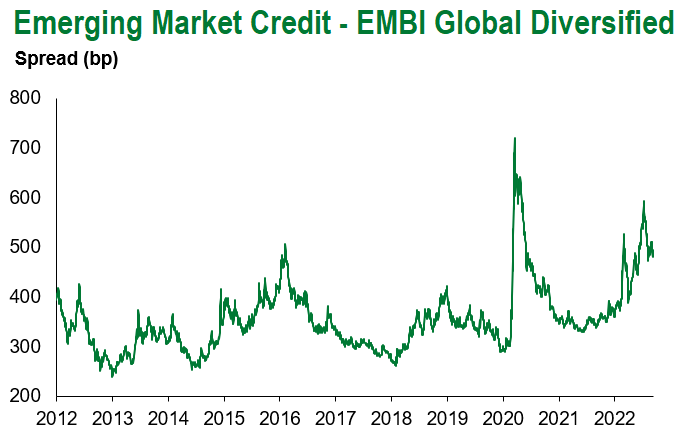
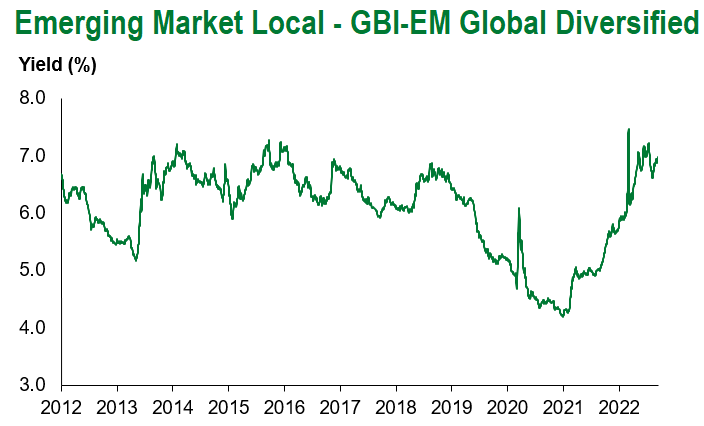
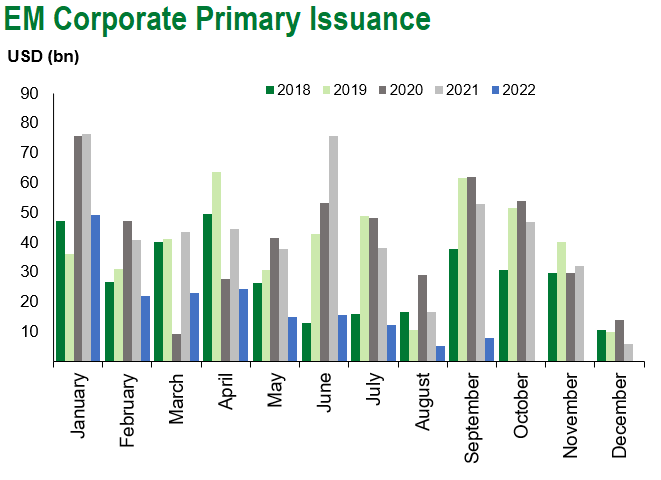
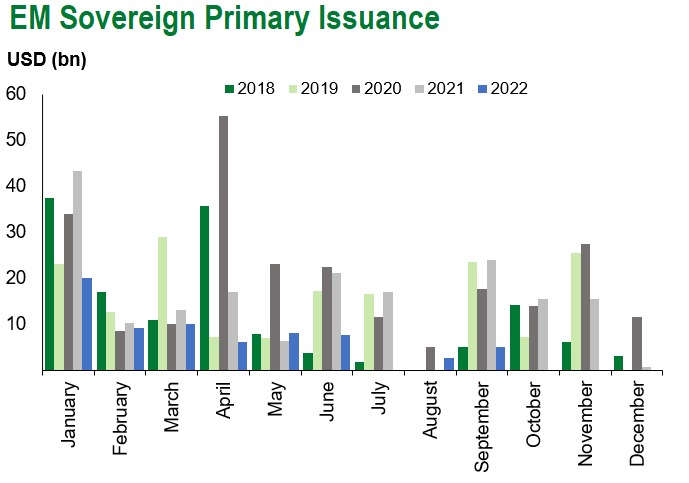
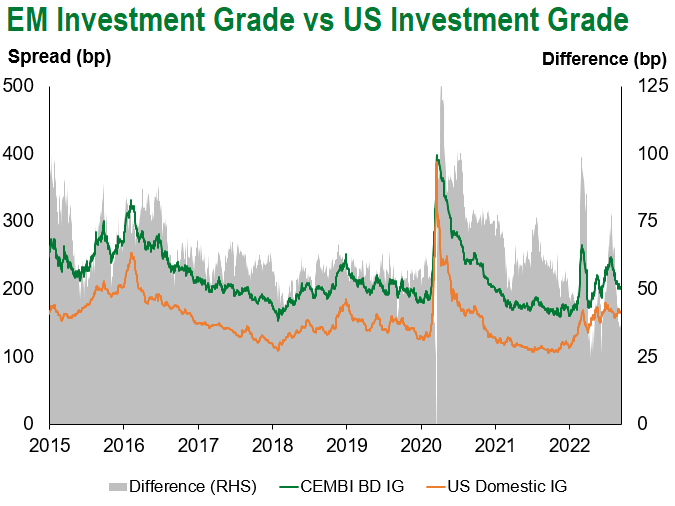
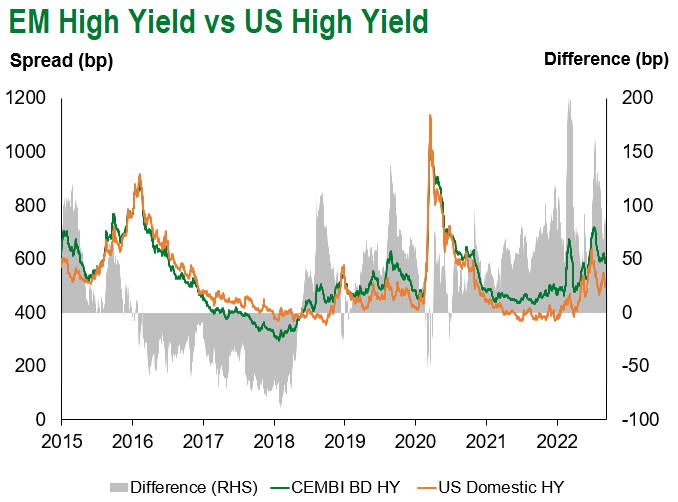
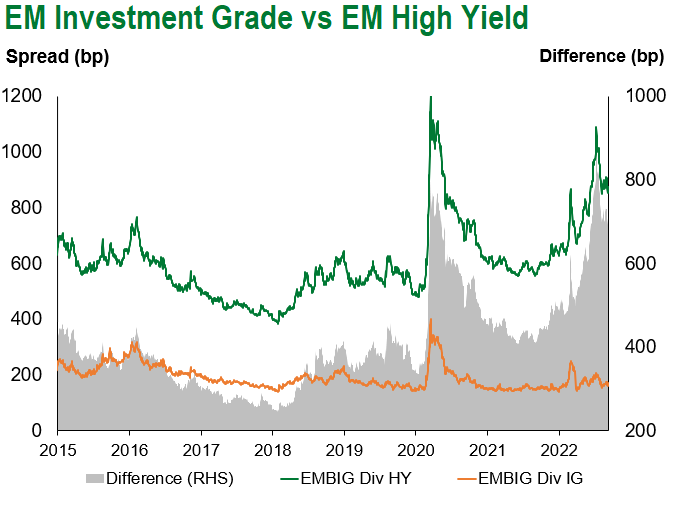
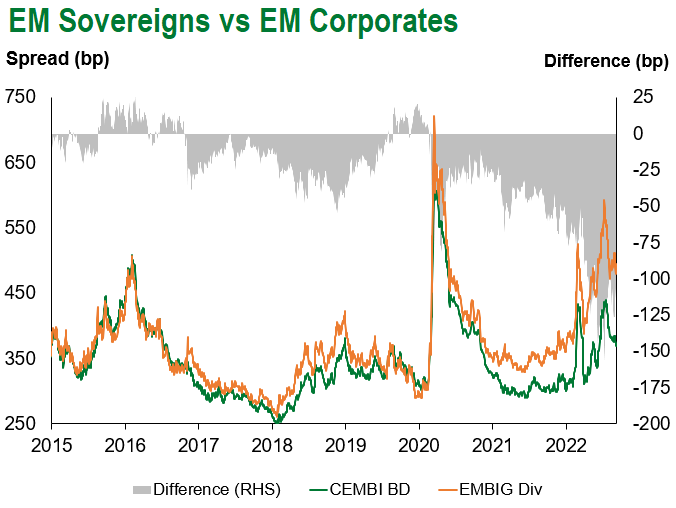
Emerging Markets Flows
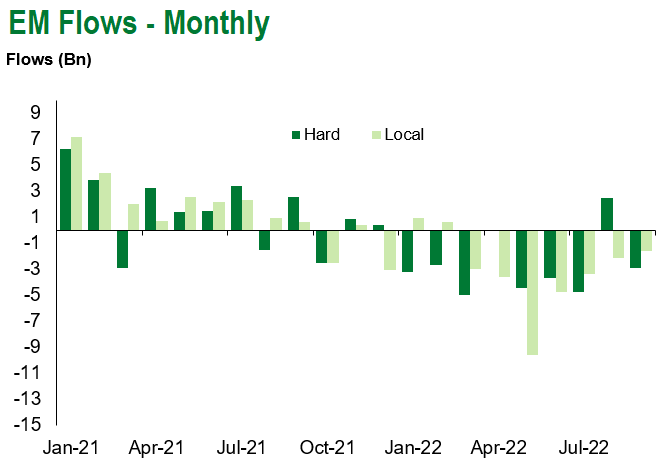
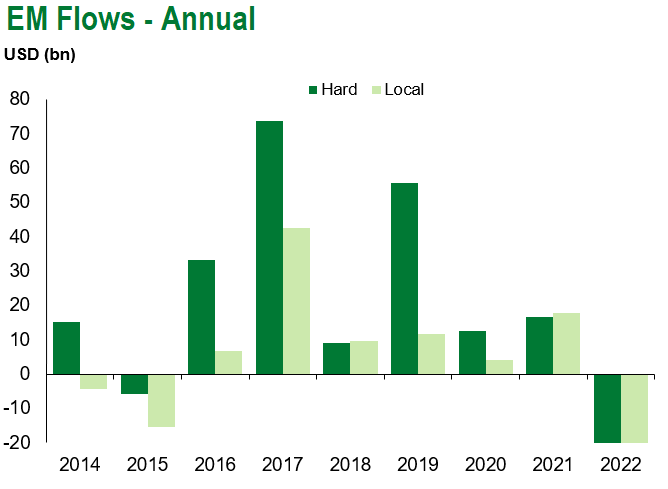
Source for graphs: Bloomberg, JPMorgan, Gramercy. As of September 16, 2022.
COVID Resources:
Johns Hopkins COVID-19 Case Tracker
For questions, please contact:
Kathryn Exum, CFA ESG, Director, Co-Head of Sovereign Research, [email protected]
Petar Atanasov, Director, Co-Head of Sovereign Research, [email protected]
James Barry, Director, Deputy Portfolio Manager, [email protected]
This document is for informational purposes only. The information presented is not intended to be relied upon as a forecast, research or investment advice, and is not a recommendation, offer or solicitation to buy or sell any securities or to adopt any investment strategy. Gramercy may have current investment positions in the securities or sovereigns mentioned above. The information and opinions contained in this paper are as of the date of initial publication, derived from proprietary and nonproprietary sources deemed by Gramercy to be reliable, are not necessarily all-inclusive and are not guaranteed as to accuracy. This paper may contain “forward-looking” information that is not purely historical in nature. Such information may include, among other things, projections and forecasts. There is no guarantee that any forecasts made will come to pass. Reliance upon information in this paper is at the sole discretion of the reader. You should not rely on this presentation as the basis upon which to make an investment decision. Investment involves risk. There can be no assurance that investment objectives will be achieved. Investors must be prepared to bear the risk of a total loss of their investment. These risks are often heightened for investments in emerging/developing markets or smaller capital markets. International investing involves risks, including risks related to foreign currency, limited liquidity, less government regulation, and the possibility of substantial volatility due to adverse political, economic or other developments. References to any indices are for informational and general comparative purposes only. The performance data of various indices mentioned in this update are updated and released on a periodic basis before finalization. The performance data of various indices presented herein was current as of the date of the presentation. Please refer to data returns of the separate indices if you desire additional or updated information. Indices are unmanaged, and their performance results do not reflect the impact of fees, expenses, or taxes that may be incurred through an investment with Gramercy. Returns for indices assume dividend reinvestment. An investment cannot be made directly in an index. Accordingly, comparing results shown to those of such indices may be of limited use. The information provided herein is neither tax nor legal advice. Investors should speak to their tax professional for specific information regarding their tax situation.
